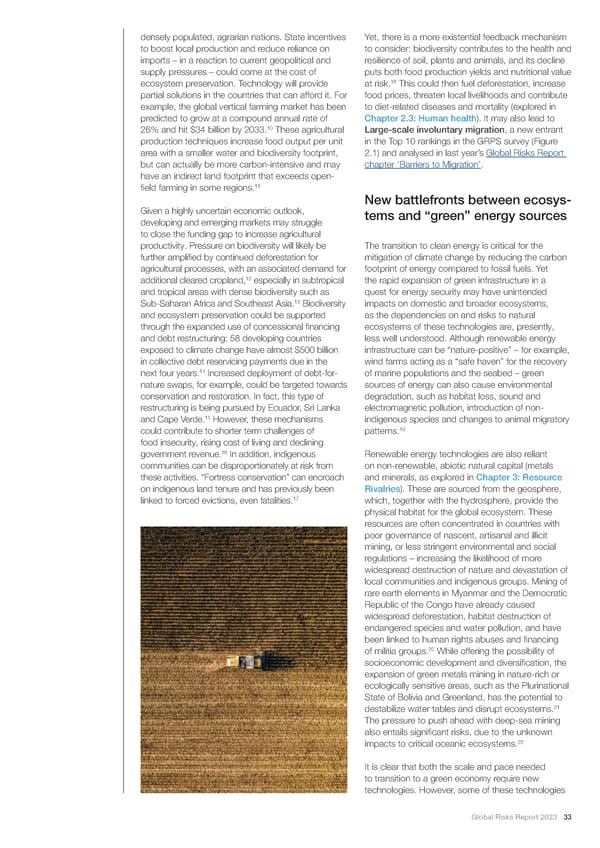densely populated, agrarian nations. State incentives Yet, there is a more existential feedback mechanism to boost local production and reduce reliance on to consider: biodiversity contributes to the health and imports – in a reaction to current geopolitical and resilience of soil, plants and animals, and its decline supply pressures – could come at the cost of puts both food production yields and nutritional value 18 ecosystem preservation. Technology will provide at risk. This could then fuel deforestation, increase partial solutions in the countries that can afford it. For food prices, threaten local livelihoods and contribute example, the global vertical farming market has been to diet-related diseases and mortality (explored in predicted to grow at a compound annual rate of Chapter 2.3: Human health). It may also lead to 10 26% and hit $34 billion by 2033. These agricultural Large-scale involuntary migration, a new entrant production techniques increase food output per unit in the Top 10 rankings in the GRPS survey (Figure area with a smaller water and biodiversity footprint, 2.1) and analysed in last year’s Global Risks Report but can actually be more carbon-intensive and may chapter ‘Barriers to Migration’. have an indirect land footprint that exceeds open- 11 昀椀eld farming in some regions. New battlefronts between ecosys- Given a highly uncertain economic outlook, tems and “green” energy sources developing and emerging markets may struggle to close the funding gap to increase agricultural productivity. Pressure on biodiversity will likely be The transition to clean energy is critical for the further ampli昀椀ed by continued deforestation for mitigation of climate change by reducing the carbon agricultural processes, with an associated demand for footprint of energy compared to fossil fuels. Yet 12 additional cleared cropland, especially in subtropical the rapid expansion of green infrastructure in a and tropical areas with dense biodiversity such as quest for energy security may have unintended 13 Sub-Saharan Africa and Southeast Asia. Biodiversity impacts on domestic and broader ecosystems, and ecosystem preservation could be supported as the dependencies on and risks to natural through the expanded use of concessional 昀椀nancing ecosystems of these technologies are, presently, and debt restructuring: 58 developing countries less well understood. Although renewable energy exposed to climate change have almost $500 billion infrastructure can be “nature-positive” – for example, in collective debt reservicing payments due in the wind farms acting as a “safe haven” for the recovery 14 next four years. Increased deployment of debt-for- of marine populations and the seabed – green nature swaps, for example, could be targeted towards sources of energy can also cause environmental conservation and restoration. In fact, this type of degradation, such as habitat loss, sound and restructuring is being pursued by Ecuador, Sri Lanka electromagnetic pollution, introduction of non- 15 and Cape Verde. However, these mechanisms indigenous species and changes to animal migratory could contribute to shorter term challenges of patterns.19 food insecurity, rising cost of living and declining government revenue.16 In addition, indigenous Renewable energy technologies are also reliant communities can be disproportionately at risk from on non-renewable, abiotic natural capital (metals these activities. “Fortress conservation” can encroach and minerals, as explored in Chapter 3: Resource on indigenous land tenure and has previously been Rivalries). These are sourced from the geosphere, 17 linked to forced evictions, even fatalities. which, together with the hydrosphere, provide the physical habitat for the global ecosystem. These resources are often concentrated in countries with poor governance of nascent, artisanal and illicit mining, or less stringent environmental and social regulations – increasing the likelihood of more widespread destruction of nature and devastation of local communities and indigenous groups. Mining of rare earth elements in Myanmar and the Democratic Republic of the Congo have already caused widespread deforestation, habitat destruction of endangered species and water pollution, and have been linked to human rights abuses and 昀椀nancing of militia groups.20 While offering the possibility of socioeconomic development and diversi昀椀cation, the expansion of green metals mining in nature-rich or ecologically sensitive areas, such as the Plurinational State of Bolivia and Greenland, has the potential to 21 destabilize water tables and disrupt ecosystems. The pressure to push ahead with deep-sea mining also entails signi昀椀cant risks, due to the unknown impacts to critical oceanic ecosystems.22 It is clear that both the scale and pace needed to transition to a green economy require new technologies. However, some of these technologies Global Risks Report 2023 33
 Global Risks Report 2023 Page 32 Page 34
Global Risks Report 2023 Page 32 Page 34